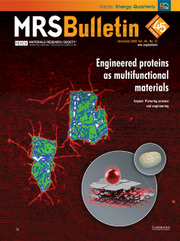Crossref Citations
This article has been cited by the following publications. This list is generated based on data provided by
Crossref.
Phulé, Pradeep P.
Mihalcin, Matthew P.
and
Genc, Seval
1999.
The role of the dispersed-phase remnant magnetization on the redispersibility of magnetorheological fluids.
Journal of Materials Research,
Vol. 14,
Issue. 7,
p.
3037.
Park, Jong Hyeok
Chin, Byung Doo
and
Park, O Ok
2001.
Rheological Properties and Stabilization of Magnetorheological Fluids in a Water-in-Oil Emulsion.
Journal of Colloid and Interface Science,
Vol. 240,
Issue. 1,
p.
349.
Shkel, Y. M.
and
Klingenberg, D. J.
2001.
Magnetorheology and magnetostriction of isolated chains of nonlinear magnetizable spheres.
Journal of Rheology,
Vol. 45,
Issue. 2,
p.
351.
Wilson, Malcolm J.
Fuchs, Alan
and
Gordaninejad, Faramarz
2002.
Development and characterization of magnetorheological polymer gels.
Journal of Applied Polymer Science,
Vol. 84,
Issue. 14,
p.
2733.
See, Howard
2003.
Magneto-rheological Suspensions - Physical Mechanisms and Modeling -.
Nihon Reoroji Gakkaishi,
Vol. 31,
Issue. 5,
p.
297.
Wereley, N. M.
Chaudhuri, A.
Yoo, J. -H.
John, S.
Kotha, S.
Suggs, A.
Radhakrishnan, R.
Love, B. J.
and
Sudarshan, T. S.
2006.
Bidisperse Magnetorheological Fluids using Fe Particles at Nanometer and Micron Scale.
Journal of Intelligent Material Systems and Structures,
Vol. 17,
Issue. 5,
p.
393.
Wang, Xiaojie
and
Gordaninejad, Faramarz
2007.
Intelligent Materials.
p.
339.
Burguera, E.F.
Love, B.J.
Sahul, R.
Ngatu, G.
and
Wereley, N.M.
2008.
A Physical Basis for Stability in Bimodal Dispersions Including Micrometer-sized Particles and Nanoparticles using Both Linear and Non-linear Models to Describe Yield.
Journal of Intelligent Material Systems and Structures,
Vol. 19,
Issue. 11,
p.
1361.
López-López, Modesto T.
Gómez-Ramírez, Ana
Durán, Juan D. G.
and
González-Caballero, Fernando
2008.
Preparation and Characterization of Iron-Based Magnetorheological Fluids Stabilized by Addition of Organoclay Particles.
Langmuir,
Vol. 24,
Issue. 14,
p.
7076.
See, Howard
and
Gordin, Andrei
2008.
Response of Carbonyl Iron-based Magneto-rheological Suspensions Under Step Changes in Magnetic Fields.
Nihon Reoroji Gakkaishi,
Vol. 36,
Issue. 1,
p.
59.
Shi, Dongyan
and
Shi, Xianjie
2010.
Research on the low-frequency vibration characteristics of the adaptive isolator based on MR damper.
p.
1707.
de Vicente, Juan
Vereda, Fernando
Segovia-Gutiérrez, Juan Pablo
del Puerto Morales, María
and
Hidalgo-Álvarez, Roque
2010.
Effect of particle shape in magnetorheology.
Journal of Rheology,
Vol. 54,
Issue. 6,
p.
1337.
López-López, Modesto T.
Kuzhir, Pavel
Durán, Juan D. G.
and
Bossis, Georges
2010.
Normal stresses in a shear flow of magnetorheological suspensions: Viscoelastic versus Maxwell stresses.
Journal of Rheology,
Vol. 54,
Issue. 5,
p.
1119.
Liao, Wei-Hsin
Zhang, Yi
and
Oyadiji, S. O.
2015.
Comparisons of the dynamic characteristics of magnetorheological and hydraulic dampers.
Vol. 9431,
Issue. ,
p.
94313C.
Hajalilou, Abdollah
Amri Mazlan, Saiful
Lavvafi, Hossein
and
Shameli, Kamyar
2016.
Field Responsive Fluids as Smart Materials.
p.
13.
Ma, Yanhong
Hu, Wenzhong
Zhang, Dayi
Zhang, Qicheng
and
Hong, Jie
2016.
Tunable mechanical characteristics of a novel soft magnetic entangled metallic wire material.
Smart Materials and Structures,
Vol. 25,
Issue. 9,
p.
095015.
Kheradmand, Saeid
Esmailian, Mojtaba
and
Fatahy, A.
2016.
A novel approach of magnetorheological abrasive fluid finishing with swirling-assisted inlet flow.
Results in Physics,
Vol. 6,
Issue. ,
p.
568.
Acharya, Subash
Saini, Tak Radhe Shyam
and
Kumar, Hemantha
2019.
Determination of optimal magnetorheological fluid particle loading and size for shear mode monotube damper.
Journal of the Brazilian Society of Mechanical Sciences and Engineering,
Vol. 41,
Issue. 10,
He, Yichao
Liang, Guanqun
Xue, Bing
Peng, Zhizhao
and
Wei, Yintao
2019.
A unified MR damper model and its inverse characteristics investigation based on the neuro-fuzzy technique.
International Journal of Applied Electromagnetics and Mechanics,
Vol. 61,
Issue. 2,
p.
225.
Kolekar, Shreedhar
Kurahatti, Rajshekar V.
Kamble, Vikram G.
and
Choi, Seung-Bok
2019.
Synthesis and Characterization of Innovative Type Magneto-Rheological Fluid.
International Journal of Nanoscience,
Vol. 18,
Issue. 06,
p.
1850041.

